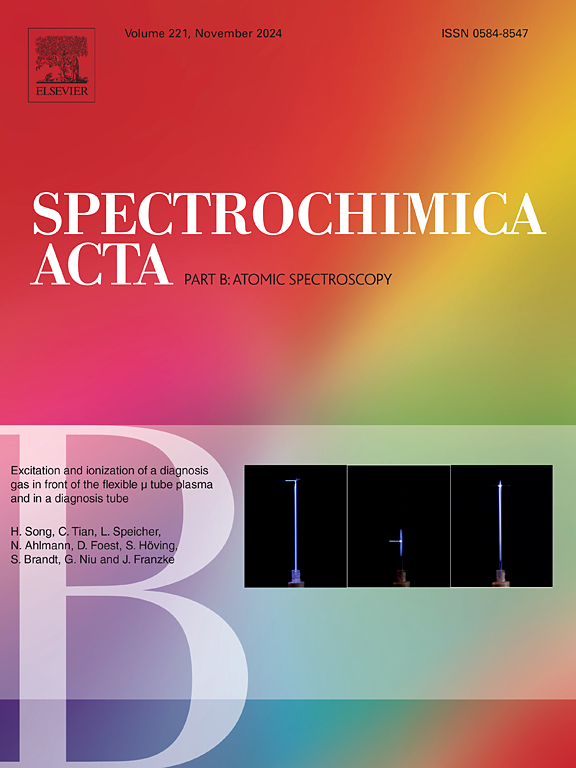电感耦合等离子体串联质谱法分析钠离子电池用NaPF6杂质
IF 3.8
2区 化学
Q1 SPECTROSCOPY
引用次数: 0
摘要
为了检测钠离子电池电解液(六氟磷酸钠,NaPF6)中的金属杂质,确保钠离子电池性能的稳定性和安全性,提出了一种新的有害金属杂质识别策略。本文采用电感耦合等离子体串联质谱(ICP-MS/MS)对NaPF6中的12种金属杂质进行了研究。将样品溶解于超纯水中,采用ICP-MS/MS直接分析,反应气体N2O/H2在MS/MS模式下消除了光谱干扰。将分析结果与扇形场(SF)-ICP-MS分析结果进行比较,并通过峰回收率试验评价所建立方法的准确性和可靠性。优化条件下,分析物的检出限为0.16 ~ 3.2 ng L−1,加标回收率为94.4% ~ 105%,相对标准偏差(RSD)为1.3% ~ 4.1%。统计分析表明,在95%的置信水平下,该方法的分析结果与SF-ICP-MS的分析结果无显著差异。该方法准确可靠,稳定性好,准确度高。基于N2O/H2反应模式的ICP-MS/MS方法在分析NaPF6中各种金属杂质方面具有很强的潜力,可以推广到其他领域,具有重要的参考价值。本文章由计算机程序翻译,如有差异,请以英文原文为准。

Analysis of impurities in NaPF6 for sodium-ion batteries by inductively coupled plasma tandem mass spectrometry
To detect metal impurities in the electrolyte of sodium-ion batteries (sodium hexafluorophosphate, NaPF6) and ensure the performance stability and safety of sodium-ion batteries, a new strategy for identifying detrimental metal impurities is proposed. In this work, inductively coupled plasma tandem mass spectrometry (ICP-MS/MS) was used to study 12 metal impurities in NaPF6. The NaPF6 sample was dissolved in ultra-pure water and directly analyzed by ICP-MS/MS, and the spectral interference was eliminated by the reaction gas mixture N2O/H2 in the MS/MS mode. The analysis results were compared with the results from sector field (SF)-ICP-MS, and the accuracy and reliability of the developed method were evaluated by a spike recovery test. Under optimized conditions, the limit of detection (LOD) of analytes was in the range of 0.16–3.2 ng L−1, the spiked recovery was in the range of 94.4 %–105 %, and the relative standard deviation (RSD) was 1.3 %–4.1 %. Statistical analysis showed that, at the confidence level of 95 %, there was no significant difference between the analysis results from the developed method and SF-ICP-MS. The developed method is accurate and reliable, with good stability and high accuracy. The ICP-MS/MS method based on the N2O/H2 reaction mode shows strong potential for analyzing various metal impurities in NaPF6, and can be extended to other fields with great reference value.
求助全文
通过发布文献求助,成功后即可免费获取论文全文。
去求助
来源期刊
CiteScore
6.10
自引率
12.10%
发文量
173
审稿时长
81 days
期刊介绍:
Spectrochimica Acta Part B: Atomic Spectroscopy, is intended for the rapid publication of both original work and reviews in the following fields:
Atomic Emission (AES), Atomic Absorption (AAS) and Atomic Fluorescence (AFS) spectroscopy;
Mass Spectrometry (MS) for inorganic analysis covering Spark Source (SS-MS), Inductively Coupled Plasma (ICP-MS), Glow Discharge (GD-MS), and Secondary Ion Mass Spectrometry (SIMS).
Laser induced atomic spectroscopy for inorganic analysis, including non-linear optical laser spectroscopy, covering Laser Enhanced Ionization (LEI), Laser Induced Fluorescence (LIF), Resonance Ionization Spectroscopy (RIS) and Resonance Ionization Mass Spectrometry (RIMS); Laser Induced Breakdown Spectroscopy (LIBS); Cavity Ringdown Spectroscopy (CRDS), Laser Ablation Inductively Coupled Plasma Atomic Emission Spectroscopy (LA-ICP-AES) and Laser Ablation Inductively Coupled Plasma Mass Spectrometry (LA-ICP-MS).
X-ray spectrometry, X-ray Optics and Microanalysis, including X-ray fluorescence spectrometry (XRF) and related techniques, in particular Total-reflection X-ray Fluorescence Spectrometry (TXRF), and Synchrotron Radiation-excited Total reflection XRF (SR-TXRF).
Manuscripts dealing with (i) fundamentals, (ii) methodology development, (iii)instrumentation, and (iv) applications, can be submitted for publication.

 求助内容:
求助内容: 应助结果提醒方式:
应助结果提醒方式:


